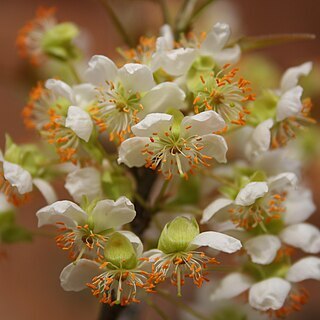Leaves petiolate; lamina 4–13 × 1·5–4·5 cm., oblanceolate to oblong-oblanceolate or rarely elliptic, rounded to shortly and ± obtusely acuminate at the apex, with margin densely curved-serrulate to crenulate, cuneate to attenuate at the base, herbaceous to chartaceous, with numerous widely spreading lateral nerves and densely reticulate tertiary venation prominent above (with main and subsidiary laterals almost equally prominent) but almost smooth below; petiole 2·5–5 (8) mm. long, slender, grooved above.
A tree. It grows to 12 m high. The bark is smooth and brown. The leaves are 5-7.5 cm long by 2-4.5 cm wide. They are pale green and glossy. There are fine teeth along the edge. The flowers are white. The flowers are in clusters of about 6. They all arise from the end of a short shoot. The fruit are 2 cm across. They are black.
Shrub or tree (1–5) 3–12 m. high, with bark pale grey-brown, flaking (? always); branches densely lenticellate, purplish-or dark brown (more rarely whitish), usually not exfoliating.
Flowers 2–6 (8), in a condensed raceme with rhachis up to 4 mm. long, or pseudumbellate; pedicels 0·8–3·1 (3·5) cm. long in fruit, articulated at or within 1 mm. of the base.
Sepals 4–6 (8) mm. long in flower, elliptic-oblong, rounded, becoming deep pink to scarlet, 6–14 (18) mm. long, often ± convex below, and ± spreading in fruit.
Stamens with anthers bright orange, 1–1·5 (2) mm. long, about-i as long as the filaments, straight, dehiscing by longitudinal slits.
Drupelets 6–8 × 4–6 mm., subglobose to subreniform, inserted below their centre; embryo somewhat curved.
Flowers white with yellow anthers, usually produced before the leaves are fully developed
Carpels (5) 6–8, with styles completely united; stigma globose or slightly 5–8-lobed.
Petals white to lemon-yellow, 7–13 x 3–7 mm., obovate, scarcely unguiculate.
Shrub or small tree, sometimes up to 40 ft. high
Sepals turning greenish and finally pink or red
Branchlets markedly lenticellate
Seeds black on the red torus.


